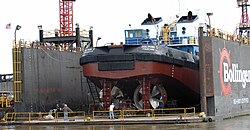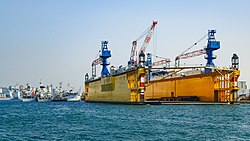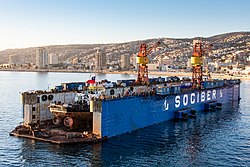Dry dock

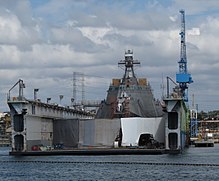
A dry dock (sometimes drydock or dry-dock) is a narrow basin or vessel that can be flooded to allow a load to be floated in, then drained to allow that load to come to rest on a dry platform. Dry docks are used for the construction, maintenance, and repair of ships, boats, and other watercraft.
History
China
The use of dry docks in
At the beginning of the dynasty (c. +965) the two Che provinces (now Chekiang and southern Chiangsu) presented (to the throne) two dragon ships each more than 200 ft. in length. The upper works included several decks with palatial cabins and saloons, containing thrones and couches all ready for imperial tours of inspection. After many years, their hulls decayed and needed repairs, but the work was impossible as long as they were afloat. So in the Hsi-Ning reign period (+1068 to +1077) a palace official Huang Huai-Hsin suggested a plan. A large basin was excavated at the north end of the Chin-ming Lake capable of containing the dragon ships, and in it heavy crosswise beams were laid down upon a foundation of pillars. Then (a breach was made) so that the basin quickly filled with water, after which the ships were towed in above the beams. Then (breach now being closed) the water was pumped out by wheels so that the ships rested quite in the air. When the repairs were complete, the water was let in again, so that the ships were afloat once more (and could leave the dock). Finally the beams and pillars were taken away, and the whole basin covered over with a great roof so as to form a hangar in which the ships could be protected from the elements and avoid the damage caused by undue exposure.[2][3]
Europe
Greco-Roman world
The Greek author
But after that a Phoenician devised a new method of launching it (the Tessarakonteres), having dug a trench under it, equal to the ship itself in length, which he dug close to the harbour. And in the trench he built props of solid stone five cubits deep, and across them he laid beams crosswise, running the laces whole width of the trench, at four cubits' distance from one another; and then making a channel from the sea he filled all the space which he had excavated with water, out of which he easily brought the ship by the aid of whatever men happened to be at hand; then closing the entrance which had been originally made, he drained the water off again by means of engines (organois); and when this had been done the vessel rested securely on the before-mentioned cross-beams.[6]
It has been calculated that a dock for a vessel of such a size might have had a volume of 750,000 gallons of water.[7]
Renaissance Europe
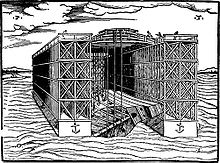
Before the 15th century, when the hull below the waterline needed attention,
Possibly the earliest description of a floating dock comes from a small Italian book printed in Venice in 1560, called Descrittione dell'artifitiosa machina.[13] In the booklet, an unknown author asks for the privilege of using a new method for the salvaging of a grounded ship and then proceeds to describe and illustrate his approach. The included woodcut shows a ship flanked by two large floating trestles, forming a roof above the vessel. The ship is pulled in an upright position by a number of ropes attached to the superstructure.
Modern era
The Saint-Nazaire's Chantiers de l'Atlantique owns one of the biggest in the world: 1,200 by 60 metres (3,940 ft × 200 ft). The Alfredo da Silva Dry Dock in Almada, Portugal, was closed in 2000. The largest roofed dry dock is at the German Meyer Werft Shipyard in Papenburg, Germany, it is 504 m long, 125 m wide and stands 75 m tall.[14]
Dry Dock 12 at Newport News Shipbuilding at 662 by 76 metres (2,172 ft × 249 ft) is the largest dry dock in the United States. The largest floating-dock in North America is named The Vigorous. It is operated by Vigor Industries in Portland, OR, in the Swan Island industrial area along the Willamette River.[15]
Types

Graving
A graving dock is the traditional form of dry dock.[16] It is a narrow basin, usually made of earthen berms and concrete, closed by gates or by a caisson. A vessel is floated in with the gates open, then the gates are closed and the water is pumped out, leaving the craft supported on blocks.
The keel blocks as well as the bilge block are placed on the floor of the dock in accordance with the "docking plan" of the ship. Routine use of dry docks is for the "graving" i.e. the cleaning, removal of barnacles and rust, and re-painting of ships' hulls.
Some fine-tuning of the ship's position can be done by divers while there is still some water left to manoeuvre it about. It is extremely important that supporting blocks conform to the structural members so that the ship is not damaged when its weight is supported by the blocks. Some anti-submarine warfare warships have sonar domes protruding beneath the hull, requiring the hull to be supported several metres above the bottom of the drydock.
Once the remainder of the water is pumped out, the ship can be freely inspected or serviced. When work on the ship is finished, the gates are opened to allow water in, and the ship is carefully refloated.

Modern graving docks are box-shaped, to accommodate newer, boxier ships, whereas old dry docks are often shaped like the ships that are planned to be docked there. This shaping was advantageous because such a dock was easier to build, it was easier to side-support the ships, and less water had to be pumped away.[citation needed]
Dry docks used for building Navy vessels may occasionally be built with a roof, to prevent
An advantage of covered dry docks is that work can take place in any weather; this is frequently used by modern shipyards for construction especially of complex, high-value vessels like cruise ships where delays would incur a high cost.
Floating

A floating dry dock is a type of
A large floating dry dock involves multiple rectangular sections. These sections can be combined to handle ships of various lengths, and the sections themselves can come in different dimensions. Each section contains its own equipment for emptying the
Shipyards operate floating dry docks as one method for hauling or docking vessels. Floating drydocks are important in locations where porous ground prevents the use of conventional drydocks, such as at the
A downside of floating dry docks is that unscheduled sinkings and off-design dives may take place, as with the Russian dock PD-50 in 2018.[20]
The "
The Great Balance Dock, built in New York City in 1854, was the largest floating drydock in the world when it was launched. It was 325 feet (99 m) long and could lift 8,000 tons, accommodating the largest ships of its day.[21]
Alternative dry dock systems
Apart from graving docks and floating dry docks, ships can also be dry docked and launched by:
- Marine railway— For repair of larger ships up to about 3000 tons ship weight
- Shiplift — For repair as well as for new-building. From 800 to 25000 ton ship-weight
- Slipway, patent slip — For repair of smaller boats and the new-building launch of larger vessels
Other uses
Some dry docks are used during the construction of bridges, dams, and other large objects. For example, the dry dock on the artificial island of
A dry dock may also be used for the prefabrication of the elements of an immersed tube tunnel, before they are floated into position, as was done with Boston's Silver Line.
Gallery
-
Thefloating drydockin the background
-
Dry Dock, Toledo Ship Building Company, Toledo, Ohio, 1912
-
Towboat Dolphin I in Bollinger Shipyards floating Drydock #2 on the Mississippi River in Algiers, New Orleans, Louisiana
-
Blohm + Voss Dock 10, at the Port of HamburgGermany
-
Floating dry dock located in Sevastopol
-
Alekseevsky dry dock at Kronstadt shipyard, Saint Petersburg, Russia
-
A boat lift is a light duty form of dry dock which keeps small boats out of the water while not in use
-
Ship in the floating dry dock of Bremer Vulkan shipyard during an inspection of its propeller and rudder
-
Floating dry dock Jong Shyn No. 8 in Kaohsiung Harbour, Taiwan
-
SOCIBER floating drydock, Valparaiso III with tugboat Pequen, being worked on in the cradle, in Valparaiso, Chile
-
The Great Balance Dock with the steamer Adriatic aboard, c. 1860
-
USS Oregon (BB-3) in dry dock, 1898
See also
- List of dry docks
- Semi-submersible – type of vessel which can partially submerge
- Space dock – Science fiction-concept
- St Nazaire Raid – British amphibious attack of 28 March 1942 — 1942 attack on a dry dock during World War II.
References
- ISBN 978-0-19-511207-8.
- ^ Needham, Joseph (1986). Science and Civilization in China: Volume 4 Part 3. Taipei: Caves Books, Ltd. Page 660
- ISBN 978-0230285453.
- ^ Oleson 1984, p. 33
- ^ Needham, Joseph (1986). Science and Civilization in China: Volume 4 Part 3. Taipei: Caves Books, Ltd. Page 660
- ^ Athenaeus of Naucratis (Yonge, C.D., Editor) The deipnosophists, or, Banquet of the learned of Athenæus, volume I, London: Henry G. Bohn, p.325 (5.204c)
- ^ Landels 2000, p. 163
- ISBN 0-86078-755-9.
- ^ Sarton 1946, p. 153
- Bodley Head. p. 39.
- ISSN 0013-8266.
- ISBN 0-297-64544-7.
- ^ Sarton 1946, pp. 153f.
- Spiegel Online. 2008-01-18. Retrieved 2009-06-25.
- ^ "North America's largest drydock floats first ship at Swan Island's Vigor Industrial (infographic and time lapse)". OregonLive.com. Retrieved 2016-11-03.
- ^ "Dry Dock, Types of Dry Docks & Requirements for Dry Dock". 9 January 2020.
- ISBN 0-471-28948-5.
- ^ Photos of USS Samuel B. Roberts on blocks in AFDB-3 in 1988
- ^ "Sea Going Navy Yard Follows The Fleet", November 1945, Popular Science
- ^ SEAN GALLAGHER (20 October 2018). "Russia's only aircraft carrier damaged as its floating dry dock sinks". Ars Technica. Retrieved 5 November 2018.
Due to interruptions in the supply of electric power to the PD-50, the floating dock dived out in an off-design mode.
- ^ Webb, William H. (January 1855). Monthly Nautical Magazine, and Quarterly Review. Griffiths, Bates.
Sources
- Landels, J. G. (2000), Engineering in the Ancient World (Revised ed.), University of California Press, ISBN 0-520-22782-4
- ISBN 90-277-1693-5
- Sarton, George (1946), "Floating Docks in the Sixteenth Century", Isis, 36 (3/4): 153–154, S2CID 144849113
External links
- Encyclopædia Britannica, dry-dock
- Carnival Liberty Cruise Ship in Dry Dock in Freeport, Grand Bahamas
- "Docks's Life". All about floating docks of shipbuilding firm "Almaz". St.-Petersburg. Russia.



